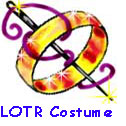

|
|
Fabric Nap
What does terry cloth, velvet, chenille, mohair and cashmere Ėto name a few-all have in common? They are fabrics with a ďnapĒ. Nap refers to the raised pile made during the weaving process - threads that stand up from the surface. Nap runs in one direction, reflecting light differently. Note: Fabrics with lettering and an obvious one way design should also be cut using a "with nap" layout. You can feel the nap by running your hand across the fabric-if it feels smooth and the pile lies flat itís with the nap, if it Ēstands upĒ and feels rougher itís against the nap. Why does this matter? The pile or nap must run in the same direction for all your pattern pieces. When cutting out pattern pieces pay particular attention to the nap and how the pieces are assembled-often it means turning fabric or pattern pieces to insure the nap runs in the same direction. If you are using a commercial pattern, there will be a "with nap" cutting diagram and different fabric requirements. If you are doing this on your own, you will need to do your own nap layout. Allow extra fabric. You can use either direction for the nap-generally if you chose against the nap the color runs darker and gives it a richer look . With the nap is a slightly lighter color and tends to wears better. If you cut your pattern pieces out with nap going up in some and down in others-it will be very noticeable, as though it is different fabrics, and napped fabrics are often the more expensive. Itís a good idea to mark your fabric on the wrong side once you have decided which way you want the nap to go in your garment. I like to mark an arrow in chalk all along the selvage so I donít get confused while laying out pattern pieces. Fur has probably the most noticeable nap, itís very easy to tell by looking at it which way the pile or nap lays. Some fabrics are more difficult and youíll have to use touch and notice the difference in how the light reflects by draping the fabric while deciding which way you want to use the nap. Nap makes us pay attention to the way light reflection can change the look of our fabric as well as the tactile feel of fabric -making sewing a richer experience for us.
This page was last updated 04/22/08 |
|||||||||